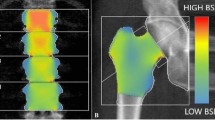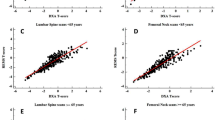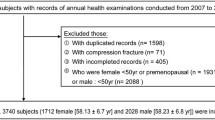Abstract
A cross-sectional, population-based study of 238 randomly selected females and 224 males with German ethnic background (aged 20–80 years) was carried out to establish lumbar spine bone mineral density (BMD) values, using dual X-ray absorptiometry (DXA), for a German population. Comparison was made to the reference range provided by the manufacturer of the DXA equipment. No sex difference in peak spine BMD was found in our study (1.091±0.114 g/cm2 for males versus 1.070±0.113 g/cm2 for females, n.s.). Different patterns of bone loss could be detected in both sexes. In premenopausal women there was no significant correlation between age and BMD (y = 1.044 + 0.00047x, r=0.03, P=0.73) whereas reduction of female BMD at the spine was demonstrated in postmenopausal women (y = 1.189−0.0041x, r=-0.28, P=0.01), underscoring the important role of the menopause for later manifestation of spinal osteoporosis in women. In contrast, in males we found no significant change of BMD with aging (y = 1.071−0.0007x, r=-0.08, P=0.25). Employing commonly used exclusion criteria, BMD values of the study subjects were found mostly within the normal range of BMD. The major finding of our study was good concordance between female data of our study population and the reference data provided by the manufacturer. Clinically significant discrepancies between our data and the Hologic reference range for males could be detected. Our data on males (30–39 years of age) were up to 7% lower than those provided by the manufacturer, probably due to differences in sampling procedures.
Similar content being viewed by others
References
Ryan PJ, Spector TP, Blake GM, Doyle DV, Fogelman I (1993) A comparison of reference bone mineral density measurements derived from two sources: referred and population based. Br J Radiol 66:1138–1141
Gärdsell P, Johnell O, Nilsson BE, Sernbo I (1991) Bone mass in an urban and a rural population: a comparative, populationbased study in southern Sweden. J Bone Miner Res 6:67–75
Elliott JR, Gilchrist NL, Wells JE, Turner JG, Ayling E, Gillespie WJ, Sainsbury R, Hornblow A, Donald RA (1990) Effects of age and sex on bone density at the hip and spine in a normal Caucasian New Zealand population. N Z Med J 103:33–36
Liel Y, Edwards J, Shary J, Spicer KM, Gordon L, Bell NH (1988) The effects of race and body habitus on bone mineral density of the radius, hip, and spine in premenopausal women. J Clin Endocrinol Metab 66:1247–1250
Runge H, Fengler F, Franke J, Koall W (1980) Ermittlung des peripheren Knochenmineralgehaltes bei Normalpersonen und Patienten mit verschiedenen Knochenerkrankungen, bestimmt mit Hilfe der Photonenabsorptionstechnik am Radius. Radiologe 20:505–514
Ringe JD (1983) Klinische Bedeutung der direkten Messung des Knochenmineralgehalts. Fortschr Med 101:186–190
Wüster C, Duckeck G, Ugurel A, Lojen M, Minne HW, Ziegler R (1992) Bone mass of spine and forearm in osteoporosis and in German normals: influence of sex, age and anthropometric parameters. Eur J Clin Invest 22:366–370
Wapniarz M, Lehmann R, Banik N, Radwan M, Klein K, Allolio B (1993) Apparent velocity of ultrasound (AVU) at the patella in comparison to bone mineral density at the lumbar spine in normal males and females. Bone Miner 23:243–252
Wapniarz M, Lehmann R, Randerath O, Baedeker S, John W, Klein K, Allolio B (1994) Precision of dual X-ray absorptiometry and peripheral computed tomography using mobile densitometry units. Calcif Tissue Int 54:219–223
Solberg HE (1987) Establishment and use of reference values. In: Tietz NW (ed) Fundamentals of clinical chemistry. WB Saunders, Philadelphia, pp 197–224
Shipman AJ, Guy GWG, Ostlere S, Smith R (1994) The bone mineral density (BMD) of 3387 Caucasian women in the Oxford area. In: Ring EFJ, Elvins DM, Bhalla AK (eds) Current research in osteoporosis and bone mineral measurement III: 1994. The British Institute of Radiology, London, p 63
Steiger P, Spencer NE, Black DM, Cummings SR, Genant HK (1990) Bone mineral density in 6515 women over 65 years of age as measured by dual x-ray and single photon absorptiometry. In: Christiansen C, Overgaard K (eds) Osteoporosis 1990, vol 2. Osteopress ApS, Denmark, pp 830–832
Laskey MA, Crips AJ, Cole J, Comston (1992) Comparison of the effect of different reference data on Lunar DPX and Hologic QDR-1000 dual-energy X-ray absorptiometers. Br J Radiol 65: 1124–1129
Looker AC, Wahner HW, Dunn WL, Caivo MS, Harris TB, Hevse SP, Johnston CC, Lindsay RL (1993) Fermoral bone density of U.S. adults. J Bone Miner Res 8 (suppl 1):S336
Kelly PJ, Twomey L, Sambrook PN, Eisman JA (1990) Sex differences in peak adult bone mineral density. J Bone Miner Res 5:1169–1175
Pouilles JM, Tremollieres F, Louvet JP, Fournie B, Morlock G, Ribot C (1988) Sensitivity of dual-photon absorptiometry in spinal osteoporosis. Calcif Tissue Int 43:329–334
Mosekilde L, Mosekilde L (1990) Sex differences in age-related changes in vertebral body size, density and biomechanical competence in normal individuals. Bone 11:67–73
Riggs BL (1991) Overview of osteoporosis. West J Med 154:63–77
Colditz GH, Martin P, Stampfer MJ, Willett WC, Sampson L, Rosner B, Hennekens CH, Speizer FE (1986) Validation of questionnaire information on risk factors and disease outcomes in a prospective cohort study of women. Am J Epidemiol 123: 894–900
Beard CM, Melton LJ III, Cedel SL, Richelson LS, Riggs BL (1990) Ascertainment of risk factors for osteoporosis: comparison of interview data with medical record review. J Bone Miner Res 5:691–698
Johnston CC, Slemenda CW, Melton LJ III (1991) Clinical use of bone densitometry. N Engl J 16:1405–1409
Riggs BL, Melton LJ III (1992) The prevention and treatment of osteoporosis. N Engl J Med 27:620–627
Pocock NA, Eisman JA, Mazess RB, Sambrook PN, Yeates MG, Freund J (1988) Bone mineral density in Australia compared with the United States. J Bone Miner Res 3:601–604
Melton LJ, O'Fallon WM, Riggs BL (1987) Secular trends in the incidence of hip fractures. Calcif Tissue Int 41:57–64
Author information
Authors and Affiliations
Rights and permissions
About this article
Cite this article
Lehmann, R., Wapniarz, M., Randerath, O. et al. Dual-energy X-ray absorptiometry at the lumbar spine in German men and women: A cross-sectional study. Calcif Tissue Int 56, 350–354 (1995). https://doi.org/10.1007/BF00301600
Received:
Accepted:
Issue Date:
DOI: https://doi.org/10.1007/BF00301600




